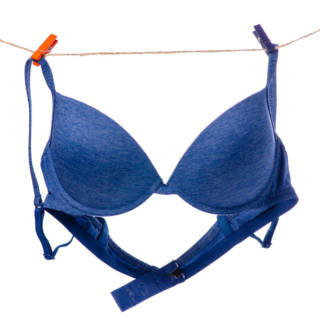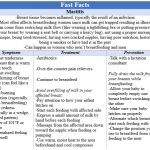What is wrong with your breast?
While getting dressed for the day, you notice that one of your breasts is tender, swollen, and warmer than the other. The affected side has redness too. It didn’t appear this way yesterday. So, what caused this to happen? How can it be fixed? Can you prevent it from occurring in the future?
 Definition
Definition
Mastitis is when the breast tissue becomes inflamed, typically the result of an infection. Most often, it affects breastfeeding women since milk can get trapped, resulting in illness. To understand how this happens, let’s take a look at the structures within each breast. Each one has numerous sections (lobules) that extend from the nipple. These are connected by thin tubes (ducts). Within a lobule, there are tiny, hollow sacs (alveoli). When you’re breastfeeding, the ducts carry the milk from the alveoli to the areola (dark area of skin in the center of the breast around the nipple). If a duct gets blocked, the milk from that lobule is unable to empty, which creates the perfect environment that allows bacteria to grow and gives rise to an infection. The bacteria can enter the breast through cracks in the skin surface.
Several things can increase your chances of developing mastitis. It can stem from restricting milk flow, like wearing a tightfitting bra or putting pressure on your breast by wearing a seat belt or carrying a heavy bag. If you don’t use a proper nursing technique, it can cause the disorder. Also, if you’re tired/stressed, have sore/cracked nipples, have poor nutrition, or smoke, your chances are higher. You’re more likely to have mastitis if you’ve had it in the past. It’s important to note that it can happen in women who aren’t breastfeeding and men if bacteria get into the breast tissue.
If not treated, mastitis can evolve into an abscess, which is a collection of pus. To remove this, you’ll need to have it surgically drained. To avoid this, it’s key to see your doctor as soon as you notice any signs of mastitis. Symptoms can appear suddenly and include breast tenderness, a breast that is warm to the touch, breast swelling, thickening of breast tissue (can feel like a lump), pain/burning sensation (especially when breastfeeding), skin redness (typically in a wedge-shaped pattern), fever of 101°F or higher, and a generalized feeling of unwell.
Treatment
Mastitis is treated by taking antibiotics. You must take the antibiotics as prescribed until they’re gone to prevent a reoccurrence of the infection. If you’re having pain in the area, your doctor will recommend taking over-the-counter pain relievers, such as acetaminophen or ibuprofen. The good news is that you can still breastfeed your baby while you have mastitis. In fact, it helps to clear the infection. If you wean your baby suddenly, it can make your symptoms worse.
Some tips to help clear the infection are to avoid overfilling of milk in your affected breast before you feed your infant. Pay attention to how your infant latches on to the affected side since it can be more challenging when your breast is enlarged. To ensure that the affected breast is completely drained during each feeding, start with that side because your infant is hungrier and will suck more strongly. It’s also helpful to express a small amount of milk by hand before each feeding. Massaging from the affected area down toward the nipple when feeding or pumping can be beneficial. Using warm, moist heat to the area beforehand and applying cool compresses afterward can relieve the discomfort. It’s essential to wear a supportive bra and rest as much as possible.
Prevention
To prevent mastitis, it’s essential to learn the proper techniques to breastfeed your infant. The best person to help you do this is a lactation consultant. One of the most important things to remember is to fully drain the milk from your breasts while breastfeeding. There are several things you can do that will aid in this, like allowing your baby to completely empty one breast before switching to the other, making sure your baby latches on properly, alternating which breast you start each feeding with, and changing the position you use to breastfeed from one feeding to the next. If you smoke, it’s a good idea to quit. If you’re having a hard time with this, your doctor can help you.
When you have a baby, mastitis isn’t something you want to experience. However, it can be treated quickly, so you’ll be back to feeling yourself in no time. If you have any questions or concerns about mastitis, please speak with your doctor. If you would like more information, please visit La Leche League International’s mastitis page at https://www.llli.org/breastfeeding-info/mastitis/